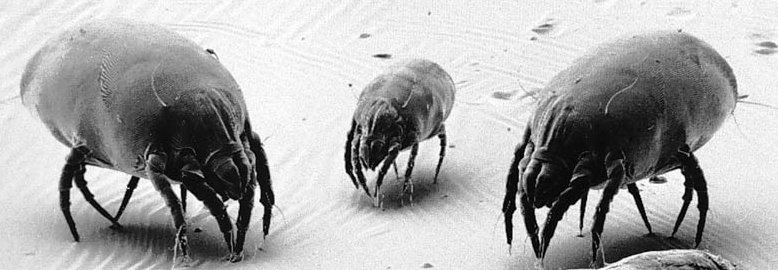Asthma is a chronic, lifelong disease, with many causes. According to the CDC, in 2020, asthma affected more than 25 million people in the US alone. Worldwide, the number is around 300 million. Some key allergens trigger both sensitization and acute attacks. The house dust mite (HDM) is recognised as a key source of major allergens responsible for asthma and other allergies, including skin rashes and rhinitis. Up to 90% of asthmatics who react to airborne material are sensitive to dust mite allergens.
House dust mites are almost invisibly small, with adults around 0.3mm in length. One gram of dust can contain 500 mites, while a mattress can hold more than two and a half million mites and the allergens they produce. The amount of mite material present increases with age. One tenth of the weight of a six-year-old pillow can consist of dust mite material. In a carpet, there can be between 1,000 and 10,000 mites per square meter. In the three months of her life, a female mite will lay 25-100 eggs.
An average mite will produce 20 feces each day of its life. These adhere to fibers in beds, carpets, and furniture, and are very difficult to remove. Attempts to remove them will break many of them up, releasing allergenic dust into the air.
Mites are Arachnids, closely related to spiders and more distantly related to insects. Two species of mites are responsible for the majority of the problem in temperate regions of the world – Dermatophagoides pteronyssinus and Dermatophagoides farinae:

As well as causing problems in adults, exposure to dust mites early in life is also responsible for sensitizing children to mite allergens. This is strongly linked to the future development of asthma.
The total costs of asthma within the United States and Europe are estimated as in excess of $100 billion each year.
In summary, dust mites are a chronic, ongoing problem and a significant cause of human disease.
CURRENT DUST MITE TREATMENTS
Despite the spending of billions of dollars annually, control of mites and their allergens by any of the currently available methods is of limited effect. A review covering 56 studies involving more than 3,000 individuals concluded that “Chemical and physical methods aimed at reducing exposure to house dust mite allergens cannot be recommended”.
These methods include:
Hot washing of infested material, which will kill mites, but is impractical for many places where mites live such as carpets, mattresses, and soft furnishings. In no case is there any barrier to immediate recolonization from nearby sources of mites.
Steam cleaning can treat mattresses, but is destructive to the materials used and has to be carried out immediately after the bed is vacated to catch the highest number of mites near the surface of the mattress. Immediate recolonization from nearby sources of mites (such as the base of the mattress) is likely.
Vacuuming is often used in an attempt to remove dust mite allergens, but is limited to accessible surfaces and is generally ineffective, reducing the amount of allergens present in carpets by only 5-10 % and having very little effect on live mites. In addition, the cleaning and the emptying of vacuum cleaners may stir up allergen-loaded dust, increasing the release of allergens into the air. Vacuuming requires the use of machines equipped with HEPA filters if the dust is not to be released, and machines with such filters can be expensive to buy and to maintain.
Air filters and room dehumidifiers are commonly used, but inside the home environment, the reintroduction of allergens or humidity from outside sources is both frequent and almost impossible to prevent.
Barrier methods, such as mattress and pillow protectors that block the access of mites to mattresses and bedding are in common use, but are also of limited value. In addition, such methods can be expensive. They are often cited as the best available option and are widely used, but they are not suitable for use with other sources of allergens, such as carpets, curtains, and upholstered furniture.
Solutions intended to inactivate allergens in carpets or on surfaces are also available. However, they require frequent re-application and are only able to treat accessible surfaces.
Acaricides are chemical agents intended to kill the mites themselves. However, the use of such pesticides can cause other problems such as both immediate and chronic toxicity effects, and they have also been associated with adverse environmental effects. Unsurprisingly, opinion is often against the use of such chemical pesticides in the domestic environment.
No single current treatment can be used for effective control of mite allergens in all areas of the home, and combined use can be complex, demanding, and expensive.
With no broadly effective control for dust mites currently available, there is a real unmet need. But there is now one approach that has the ability to exert control throughout the house, spreading out from limited initial applications to reach even difficult-to-access areas.
That technology is biological control. Widely used and proven in agriculture, it is now being applied to benefit human health.
Aeris Biotechnologies is the leader in applying this approach, with its exclusive, patent-protected technology. Aeris is now developing its novel, ecologically friendly biological control targeting house dust mites. Details can be found at www.aerisbiotech.com with a short video available online at https://youtu.be/6CLWcPVs9m4









